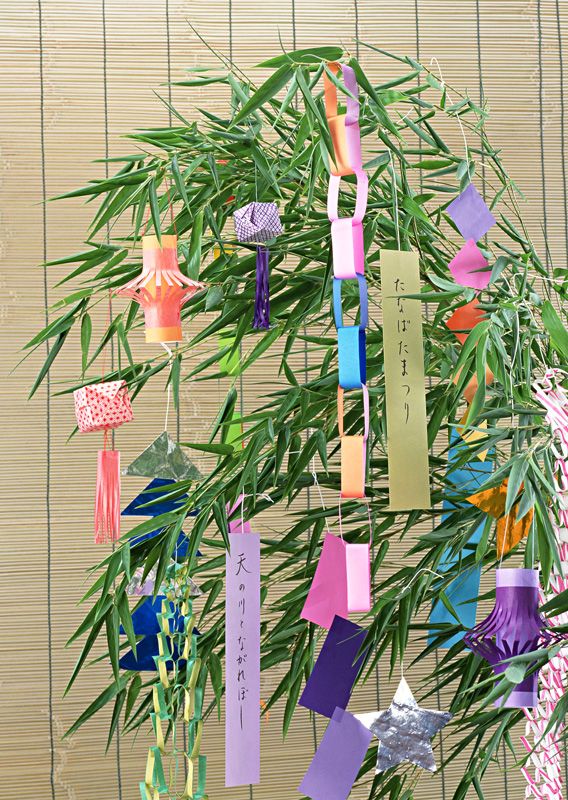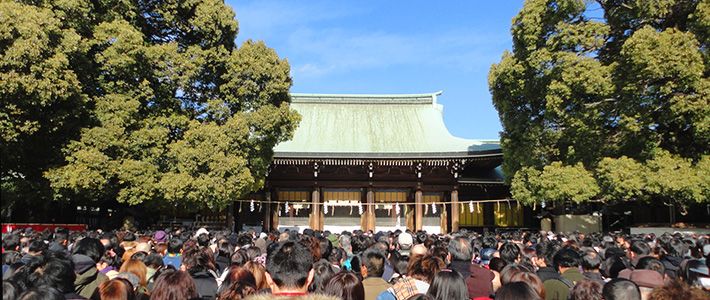
Customs, Festivals, and Observances: The Japanese Year
Society Culture Lifestyle- English
- 日本語
- 简体字
- 繁體字
- Français
- Español
- العربية
- Русский
January
Shōgatsu
Traditionally a term for the first month of the year, Shōgatsu nowadays refers more specifically to January 1, New Year’s Day. Customs surrounding the New Year make up the most important event in the Japanese calendar. A typical family might decorate the porch, household shrine, or ornamental alcove (tokonoma), don traditional Japanese clothing, eat ozōni, and head out to a shrine or temple for the customary hatsumōde, the first shrine visit of the year. It is also common to rise early (or stay up late!) to watch the first sunrise of the year, or hatsuhinode.
Ozōni, a dish with lots of regional variations, is a fish-based soup, usually served with rice cakes known as mochi. Children and teenagers receive gifts of money (otoshidama) and enjoy traditional pastimes such as flying kites or playing the badminton-like hanetsuki and sugoroku, a board game. Most activity across the land shuts down for sanganichi, the first three days of the year. There is a custom of doing calligraphy on January 2, while on January 7 many people pray for good health as they eat nanakusa-gayu, a type of rice porridge made with seven types of greens. On January 11, families will eat the kagami-mochi rice cake that had been laid out as an offering on their shrine or altar and pray for harmony in the year ahead. This custom is known as kagami-biraki, “opening the mirror.”
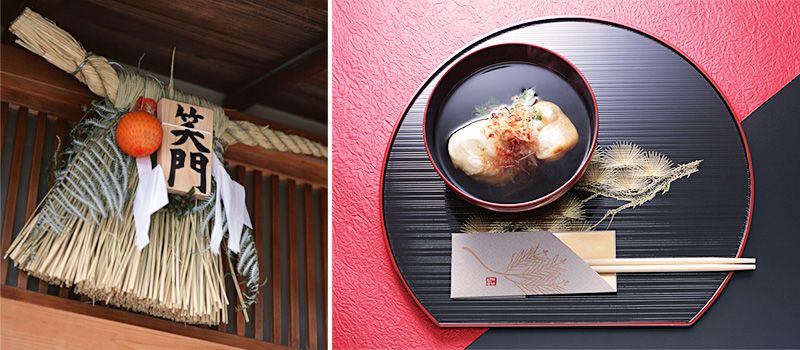 (Left) Traditional New Year shimekazari decoration at the entrance to a house. (Right) Ozōni is a popular dish at New Year.
(Left) Traditional New Year shimekazari decoration at the entrance to a house. (Right) Ozōni is a popular dish at New Year.
Seijin Shiki: Coming of Age Ceremony
The second Monday in January is a national holiday, Coming of Age Day. Around this date, most municipalities hold a ceremony to which all the local 20-year-olds are invited. Many of these young people, especially young women, attend in traditional Japanese garments such as furisode (kimono with long sleeves) and hakama (formal pleated unisex skirts worn over a kimono).
Nyūgaku Shiken: Entrance Examinations
Centralized university entrance examinations take place across Japan in mid-January, along with similar tests for the various other levels of the school system. While the number of children in the country is considered to be worryingly low, the competition for places at the most popular schools can still be exceptionally fierce, a topic which often makes the national news around this time of year.
February
Setsubun
Setsubun, which takes place around February 3 or 4, is a day that marks the end of winter according to the old Japanese lunisolar calendar. People customarily scatter beans around the home as a means of warding off ill fortune, chanting oni wa soto, fuku wa uchi, or “Out with demons! In with luck!”
Hatsu-uma
The first day of the horse in February is known as hatsu-uma (literally “first horse”) and is celebrated in honor of Inari, revered as the god of (among other things) fertility and agriculture. Lively festivals are held at Inari jinja, shrines to Inari, across the country. In some places, pieces of mochi are thrown into the assembled crowd.
March
Hinamatsuri: The Peach Festival
Hinamatsuri (“doll festival”) is a time to give thanks for the healthy growth of young girls. People decorate their houses with hina dolls, to which they make offerings of white sake, colorful arare mochi glutinous rice crackers, and peach blossoms. Two common dishes associated with this festival are chirashi-zushi, a dish with sushi toppings served on a bed of vinegared rice, and broth made with hamaguri clams.
Higan
Higan is a weeklong observance in late March, occupying the three days on either side of the spring equinox. In Japan, the periods surrounding the spring and autumn equinoxes are an important chance to visit family graves and hold memorial services for deceased relatives and ancestors. People often eat rice cakes covered in sticky, sweet bean paste, botamochi, or a seasonal variant called ohagi.
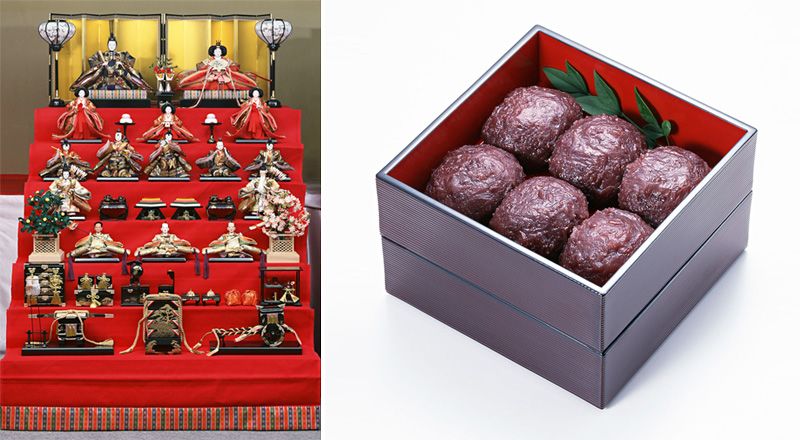 (Left) A display of hina dolls. (Right) Ohagi (also called botamochi) are often eaten at Higan.
(Left) A display of hina dolls. (Right) Ohagi (also called botamochi) are often eaten at Higan.
April
Hanami
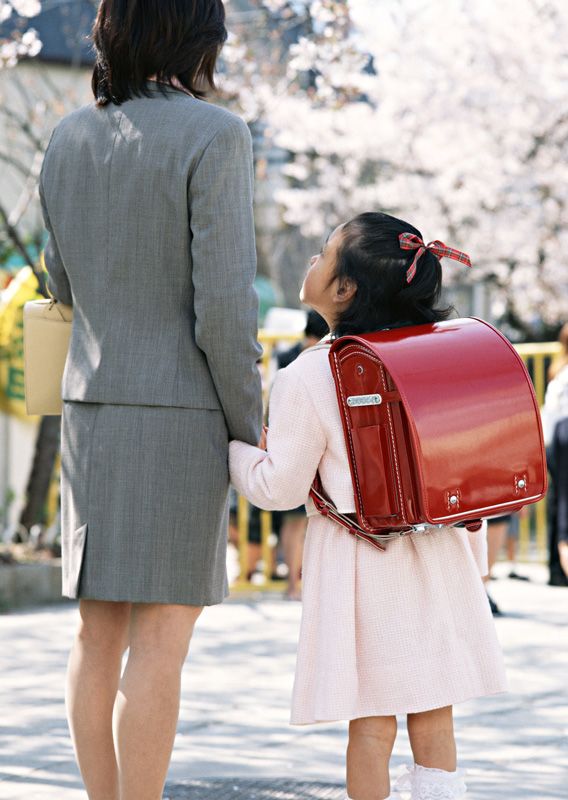 Families on their way to elementary school entrance ceremonies are a common sight in April.
Families on their way to elementary school entrance ceremonies are a common sight in April.
The spring custom of strolling and picnicking beneath the cherry blossoms—which start to bloom in Kyūshū and west Japan from late March and move northwards across the country—is known as hanami (literally “flower viewing”). The prime season in Tokyo typically comes in early April and lasts for a week or so. Well-known hanami spots invariably become densely thronged with crowds savoring the transient beauty of the fluffy pink blooms.
Nyūgaku Shiki: School Entrance Ceremonies
The academic year starts in April, when children of all ages are welcomed to their new schools at entrance ceremonies, or nyūgaku shiki. Parents and other family members dress up smartly for the occasion. In the case of some of the larger universities, as many as 10,000 students may be present at a given ceremony.
Kanbutsue/Hana Matsuri: Buddha’s Birthday
Kanbutsue, a celebration of the birth of the Gautama Buddha, in Japan is observed on April 8. People visit shrines and temples where, in an act of reverence, they might pour sweet tea over a statuette of the Buddha mounted under an awning on a flower-decorated hanamidō altar (hence giving this day its other name, hana matsuri, “the flower festival”).
Golden Week
The weeklong string of holidays stretching from Shōwa Day on April 29 to Children’s Day on May 5 is known as Golden Week. The period also takes in Constitution Memorial Day (May 3) and Greenery Day (May 4), tempting company workers to take the extra few days off and travel for a week or more. The succession of public holidays, combined with the generally pleasant weather characteristic of the season, mean that festivals, sporting events, and holiday spots tend to draw staggeringly large crowds.
May
Tango no Sekku: Children’s Day
Tango no sekku, nowadays more frequently referred to as Children’s Day, is a festival held every May 5 to give thanks for the healthy growth of young boys. Carp streamers adorning the roofs of houses are a common sight around this time. Inside the home, many people display samurai figures, helmets, or armor. Many also take the opportunity to refresh themselves with a traditional bath infused with sweet flag leaves.
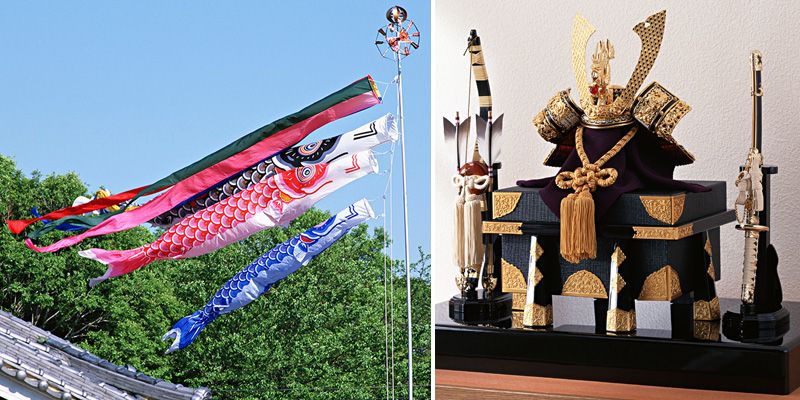 (Left) Colorful carp streamers, flown to mark Children’s Day. (Right) Decorative armor on display in a home.
(Left) Colorful carp streamers, flown to mark Children’s Day. (Right) Decorative armor on display in a home.
June
Tsuyu: The Rainy Season
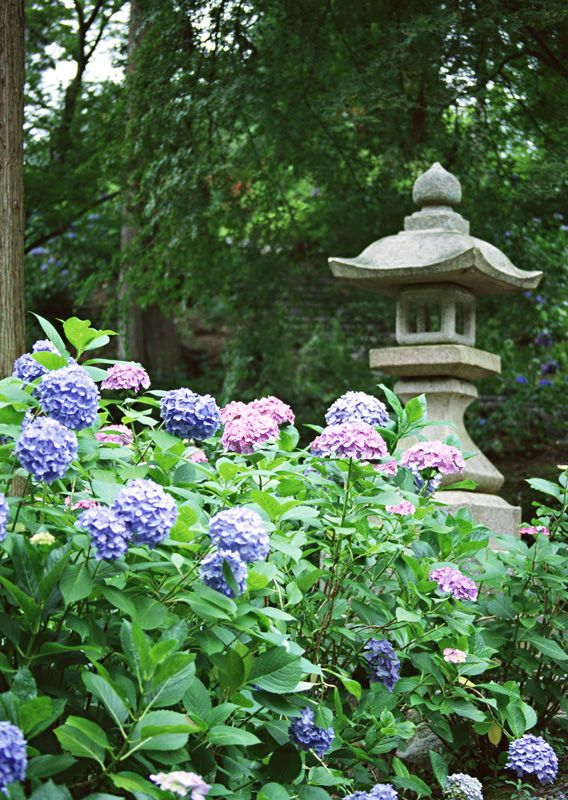 Hydrangeas, which bloom during the rainy season.
Hydrangeas, which bloom during the rainy season.
The rainy season in Japan (known as tsuyu or baiu) starts around the end of spring and, in the area ranging from the north of Kyūshū up to Kanto, typically lasts from early June until mid-July. Many of the traditional festivals held in this period originally started with the aim of warding off the epidemics and agricultural pests common at this time of year. Some of the best-known examples include the Gion Matsuri in Kyoto (July 1–31) and the Tenjin Matsuri in Osaka (July 24–25).
July
Tanabata
Tanabata, which takes place on July 7, is a festival that has its origins in a Chinese legend concerning the herdsman Hikoboshi (represented by Altair, brightest star in the constellation Aquila) and the weaver maiden Orihime (Vega, brightest star in the constellation Lyra). There is an associated custom of writing wishes on pieces of colored paper and tying them to decorative bamboo branches. Tanabata festivals are held across the country, although the well-known Sendai Tanabata matsuri takes place a month later, running for three days from August 6.
Obon
The Buddhist custom of paying tribute to the spirits of deceased relatives and ancestors is known as Obon. These spirits are said to revisit the homes of their family from July 13 before returning to the afterworld three days later, on the evening of July 16. Many families adorn their home shrine, or butsudan, with special decorations and offerings and have a priest recite a sutra for them. Despite the official dates for Obon, in most areas of Japan the custom is actually practiced a month later, around August 15. Although there are no official public holidays associated with this tsukiokure (month-late) Obon, many employers grant their staff time off.
Bon Odori
Around Obon, many people dress in yukata and gather in the local town square or at a shrine to dance in a circle to the rhythm of traditional songs. This custom, known as bon odori, also originated as a tribute to the souls of the dead, but has in most cases diverged from these roots to become more a communal way of enjoying the hot summer nights. These gatherings were also once seen as an excellent opportunity for young, unmarried men and women to mingle and find a partner.
Summer Holiday
The summer holiday for most schools stretches from late July until the end of August. The popular National High School Baseball Championship typically takes place from August 8. From late July until tsukiokure Obon in mid-August, fireworks displays are held across the country. One of the biggest such events, the Sumida River Fireworks Festival in Tokyo, is held on the last Saturday in July and often attracts as many as a million spectators.
August
Peace Memorial Ceremonies, War Memorial Day
From the Peace Memorial Ceremonies in Hiroshima and Nagasaki (August 6 and 9, respectively)—held to mark the anniversaries of the atomic bombings of the two cities in 1945—through to War Memorial Day on August 15, which commemorates the end of World War II, the national media is filled with campaigns calling for nuclear disarmament and prayers for world peace. The period is seen as an opportunity to reflect on the horrors of war and to remember those who have lost their lives in such conflicts throughout the ages.
Homecoming
Much like the New Year, tsukiokure Obon (see above) is an important time for families to get together. Many employers in the larger towns and cities grant their staff time off to visit parents and other relatives in their hometowns. The period is characterized by dense traffic jams and extreme crowding on all branches of the transport network, giving rise to the now commonly used term kisei rasshu (literally “homecoming rush”).
September
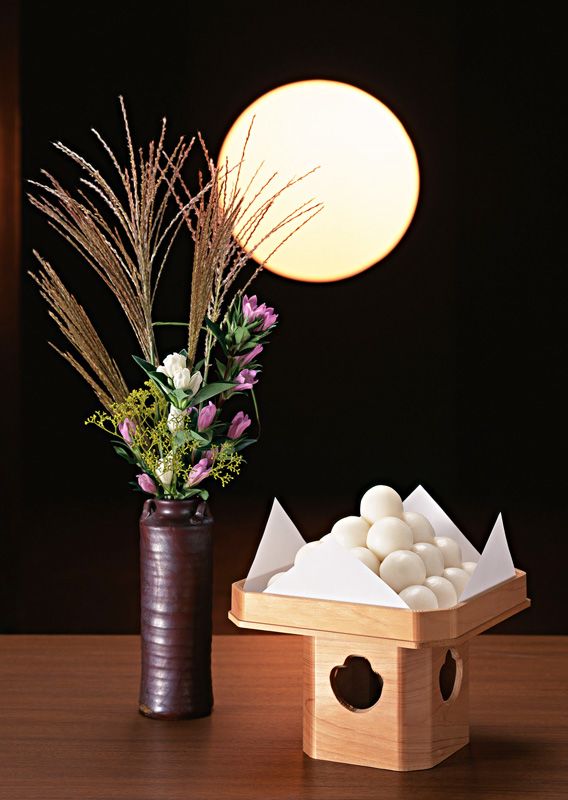 Tsukimi decorations, including tsukimi dango.
Tsukimi decorations, including tsukimi dango.
Aki no Higan: The Autumn Equinox
Aki no higan is a weeklong observance in late September, occupying the three days either side of the autumn equinox. The customs associated with this festival are much the same as for its spring equivalent in March (see above).
Tsukimi
Tsukimi, literally “moon viewing,” is a custom that presents the opportunity to savor the beauty of a clear autumn sky illuminated by a full moon. The custom was traditionally observed—according to the old Japanese lunisolar calendar—on the fifteenth day of the eighth month and the thirteenth day of the ninth month, dates that today correspond to mid-September and mid-October, respectively. The viewing area is commonly decorated with eulalia grass, while customary fare includes round dumplings called tsukimi dango, chestnuts, and sake.
October
Undōkai: Sports Festivals
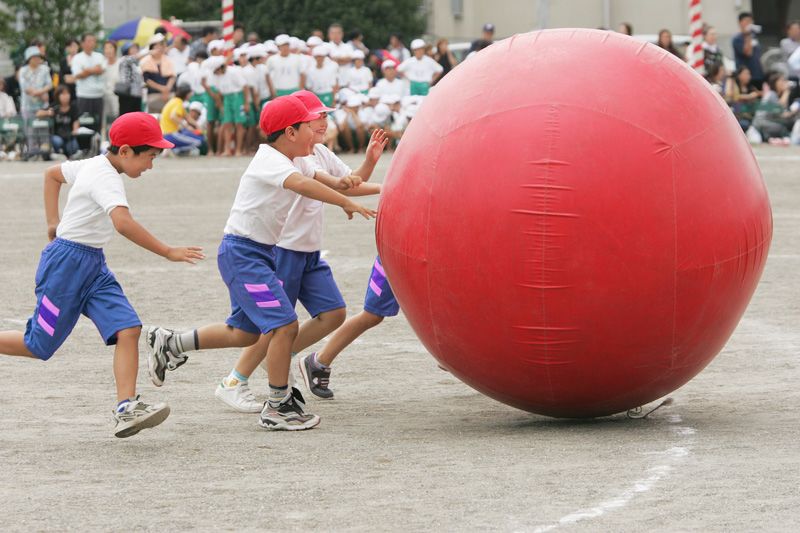 Elementary school students roll a giant ball at their school sports festival, or undōkai.
Elementary school students roll a giant ball at their school sports festival, or undōkai.
The 1964 Tokyo Olympics began on October 10 that year. In 1966, October 10 was declared Health and Sports Day, and a national holiday has been observed on the second Monday of the month since 2000. On or around this date, many schools and municipal facilities hold a sports festival known as an undōkai, a lively, daylong event featuring track and field competition, as well as gymnastics and dancing. Companies also sometimes organize undōkai to foster stronger bonds among employees and their families. Because it is such an essential part of the calendar at all levels of schooling, in areas outside of the big cities it is not uncommon to hold a single event in which a number of local schools take part together.
November
Shichi-Go-San
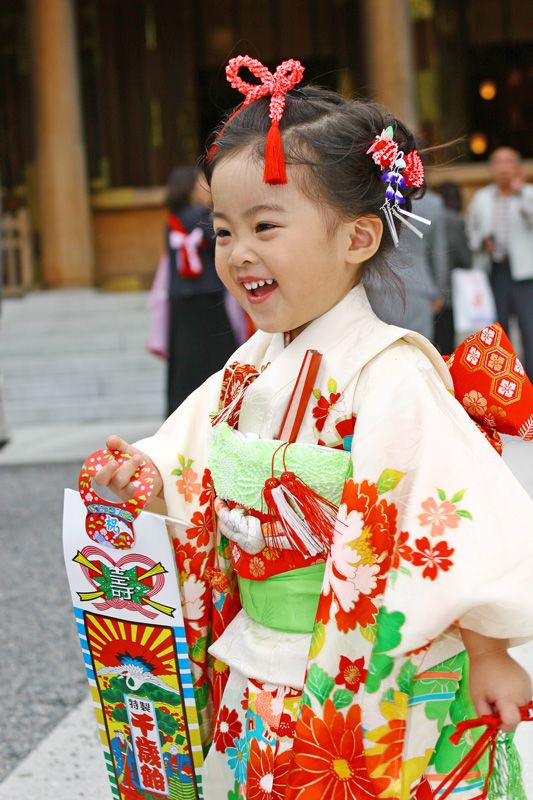 A young girl in traditional dress visiting a temple for shichi-go-san.
A young girl in traditional dress visiting a temple for shichi-go-san.
For Shichi-Go-San (literally “seven-five-three”) on November 15, young girls aged three and seven and five-year-old boys are dressed in their finest clothes and taken to visit shrines. This custom is observed both to give thanks for the children’s sound growth to date and to pray for continuing good health.
December
Bōnenkai
Heading into December, many people get together with workmates or friends from other clubs or social groups at a bōnenkai, a party literally aimed at “forgetting the year,” or at least the hardships seen during it. It is one event at which social hierarchies and the attendant etiquette characteristic of much of Japanese life can be set aside, and all in attendance join in the revelry on an equal footing.
Kotohajime
From December 13, in a custom known as kotohajime (literally “beginning of work”), people start to prepare for the New Year by thoroughly cleaning their homes. Typical chores include the dusting of household shrines and other religious artefacts, along with procuring the necessary items to make mochi and other seasonal treats.
Christmas
Although Japan is not a traditionally Christian country, Christmas is these days widely observed as a commercial event. Children eagerly await the arrival of Santa Claus with their presents, and many homes put up Christmas trees and other decorations. Thanks to the tradition of eating Christmas cake (which in Japan usually means a strawberry cream sponge cake), Christmas Eve has in recent times become an exceptionally busy day for the nation’s confectioners.
Banner photo:Crowds paying a traditional New Year’s visit to Tokyo’s Meiji Shrine. This shrine is typically visited by as many as 3 million people in the first three days of January each year.
